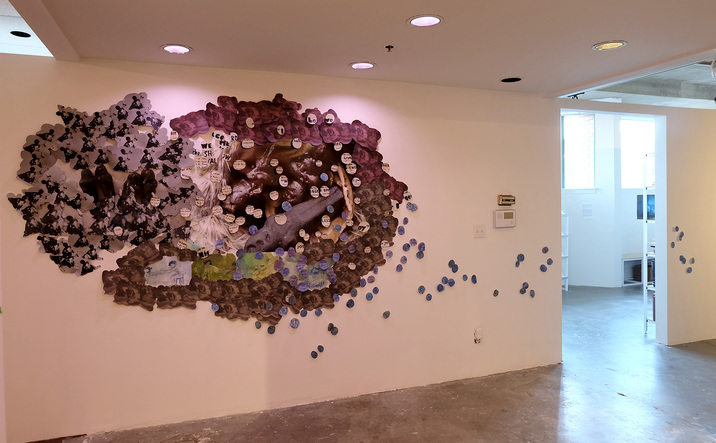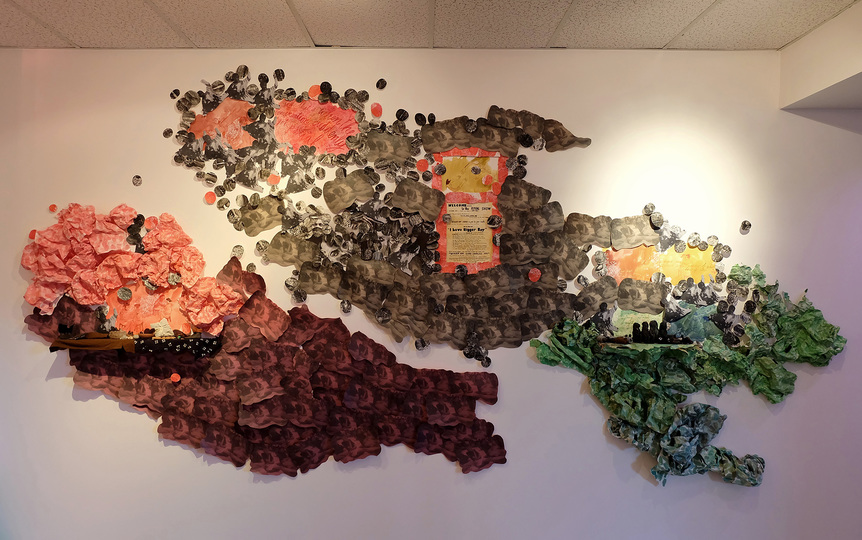-
From Current Issue
-
- Editor’s Letter Fire in the Heart
- Reviews I Gusti Ayu Kadek Murniasih
- Reviews 11th Seoul Mediacity Biennale: “One Escape at a Time”
- Dispatch Networked China
- One on One Monira Al Qadiri on Yukio Mishima
- Essays The rise of independent art spaces in pandemic-era Shanghai
- Features Tuan Andrew Nguyen
- Table of Contents
- Web Exclusives
- Archive
- Subscribe

R
E
V N
E
X
T
Installation view of LUCIE CHAN’s To Be Free, Everything You Most Hate and Fear, 2018–19, videos, drawings, sound, organic matter, prints, photographs, and found objects, dimensions variable, at Centre A, Vancouver, 2020. All images courtesy Centre A.
In a social climate of superficial minority representation and the conditionality of racial equality, Lucie Chan’s exhibition “To Be Free, Everything You Most Hate and Fear” stood out for encouraging viewers to question their unconscious roles in perpetuating ideas of a racialized Other. The multidisciplinary project created an immersive experience of contradictory and clashing aesthetics, reflecting the indefinability of one’s identity, much like the artist’s mixed African, Chinese, South Asian, and Portuguese heritage. Displayed at Centre A (The Vancouver International Centre for Contemporary Asian Art), Chan’s show tackled the diversity and nonconformity of what it means to be a person of color.
Viewers were first met with a monumental collage of enlarged photographs of licorice candy overlapped with cutouts of images, paintings, and text. Painted illustrations of seated conversations, alluding to the need for human companionship and understanding, line the bottom of the collage, while pictures of African-American schoolchildren from Detroit meditating frame the borders. Although outsiders often view the city as being plagued by gang violence and impoverishment, these peaceful scenes of children attest to the moments of beauty that can be found in Detroit if one cares to take a closer look. Additional grayscale cutouts of a young African boy are layered repeatedly from the left-hand-side of the composition, which appears topographical from afar. Up close, this image dissipates, punctuated by blue cutouts and circular yellow papers with text extracted from a 1950s poster shown on the adjacent wall.
Framed with scrunched-up green and red painted paper, the poster, emblazoned with the phrase “I Love Nigger Boy,” promotes a brand of human-shaped licorice candy as a healthy staple for the quintessential American family. This advertisement manifests a blatantly racist past still prevalent at the time and space of Chan’s show. In fact, the artist conceived the exhibition upon finding these candies still being sold in Canada today, rebranded as “licorice babies” or, more problematically, “black babies.” Overpowering large-scale photographs of them line the entirety of another wall, complemented by the actual candies and larger sculptural replicas displayed throughout the exhibition alongside other found and crafted objects. All these elements work together to represent the undercurrents of racism that continue to pervade society today, no matter how “benign” or suppressed.
On the opposite wall, portraits of contemporary African-North American artists, including Hank Willis Thomas and Kapwani Kiwanga take up the whole surface. The notion that these figures—some of whom are widely acclaimed—might soon be forgotten is highlighted through the selective erasure of their faces. Here, Chan suggests that in a time when representation and meaningful opportunities are not synonymous, the success of these artists may be constrained by the tokenism of predominantly white-controlled platforms, where they risk being defined by their ethnicities rather than their artistic abilities. The placement of a list of the artists’ handwritten names in another room emphasized the disassociation between a recognized name and the oppressed body it represents. Hung next to the portraits, a handwritten poem composed of words excerpted from protest posters convey the need for camaraderie and compassionate understanding that transcends borders.
An audio recording plays softly throughout the installation, telling the story of Chan’s deceased Batswana friend whose jovial optimism turned into disillusionment under the crumbling pressure of assimilation upon immigrating to Canada. “To Be Free” revealed how cycles of oppression continue to haunt people of color regardless of how far we have seemingly come as a society. Beyond evoking a sense of discomfort when viewed, the exhibition stood as a reminder that for people of color, this discomfort does not stop when they look away. Instead, racism and the legacies of historical oppression force themselves into their lives, even packaged as innocently as candy. This was an exhibition that challenged the preconceived Western liberal notions of racial diversity and reparative progress, posing the question: Is it really possible to be free when you are constantly hated and feared?
Lucie Chan’s “To Be Free, Everything You Most Hate and Fear” is on view at Centre A, Vancouver, until March 14, 2020.
To read more of ArtAsiaPacific’s articles, visit our Digital Library.



















